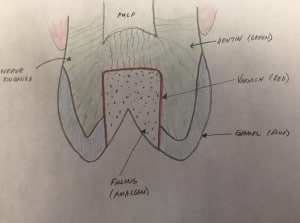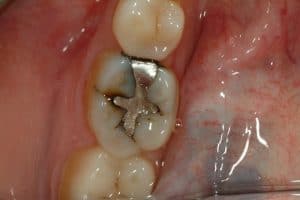When I do examinations, I often use the term “leaking” to describe the condition of old silver-amalgam fillings to my patients. What leaking means in this case is that the seal between the tooth and the filling material has been lost, at least to some degree. When amalgam (silver filling material) is first placed into the tooth, a coat of sealer called “varnish” is painted on the internal surface of the cavity preparation right before the silver is “packed” into the hole. The “cavity preparation” is the hole in the tooth left after the decay is removed. The varnish is a sticky substance similar to the type of varnish placed on wood to give it a protective coating. The varnish actually does two things: 1) it seals the inner part of the tooth called “dentin” that has small nerve endings, and 2) it allows a seal to form between the filling material (amalgam) and the enamel. The varnish seal starts to “leak” after decades of exposure to the mouth environment.
The first sign that the filling has started to leak is a faint grayish discoloration of the enamel around the filling. The gray—or sometimes almost black—discoloration, is the result of fluids from the mouth causing corrosion of the silver within the amalgam filling. Amalgam is a mixture of silver, tin, copper, and mercury. Silver tarnishes black when it is exposed to oxidation; a common example of this is the black residue that forms on silverware after being stored in a cabinet for years. Polishing can remove this black residue from silverware but it permanently stains tooth structure and more deeply stains the dentin layer of the tooth because dentin is more porous than the hard enamel layer.
The dark staining of the tooth is unsightly, however, the bigger concern is the decay that inevitably follows this leaking process. If fluids are allowed to get between the tooth and the filling material, so are bacteria, which are responsible for tooth decay. Therefore, it’s safe to assume that if you have a filling that’s been in your mouth for twenty years or more, and has a dark “halo” around the edges, there is bound to be decay under that filling as well. Because the long-term health of a tooth is directly proportional to how much healthy tooth structure remains, it’s prudent to have those leaky fillings replaced as soon as possible; once the leaking starts and allows the decay process to begin, it won’t stop on its own. The filling must be completely removed so the decay can be excavated from the tooth and a new filling can be placed. In most cases, the new filling material would be a white material called composite, which has its own limitations but doesn’t cause this dark staining of the tooth. In some cases, where there is a significant amount of tooth loss due to decay, an onlay or crown may be placed rather than a filling.
Although amalgam fillings do eventually start to leak and need to be replaced, it’s remarkable how long this material can last. Because of its dark color, tendency to eventually stain teeth, propensity to create cracks in teeth, along with other minor drawbacks. including concerns about the mercury within the material, amalgam is being slowly phased out of dentistry. My guess is that we won’t see much of it being used after the next 10-15 years.


